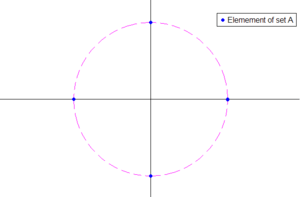Shattered set
| Look up shattered set in Wiktionary, the free dictionary. |
The concept of shattered sets plays an important role in Vapnik–Chervonenkis theory, also known as VC-theory. Shattering and VC-theory are used in the study of empirical processes as well as in statistical computational learning theory.
Definition
The ingredients in the definition of shattering are:
- A - a set. For example: a finite set of points.
- C - a class of sets. For example: the class of discs in the plane (each circle is a set of points).
The class C is said to shatter the set A if, for each subset a of A, there is some element c of C such that
Equivalently, C shatters A when the power set P(A) = { c ∩ A | c ∈ C }.
For example, the class C of all discs in the plane (two-dimensional space) cannot shatter every set A of four points, yet the class of all convex sets in the plane shatters every finite set on the (unit) circle. (For the latter result, connect the dots!)
We employ the letter C to refer to a "class" or "collection" of sets, as in a Vapnik–Chervonenkis class (VC-class). The set A is often assumed to be finite because, in empirical processes, we are interested in the shattering of finite sets of data points.
Example
Suppose we have a set A of four points on the unit circle, and we wish to know if it is shattered by the class C of all discs.

To test this, we attempt to draw a disc around every subset of points in A. First, we draw a disc around the subsets of each isolated point. Next, we try to draw a disc around every subset of point pairs. This turns out to be doable for adjacent points, but impossible for points on opposite sides of the circle. As visualized below:
-

Each individual point can be isolated with a disc (showing all four).
-

Each subset of adjacent points can be isolated with a disc (showing one of four).
-

A subset of points on opposite sides of the unit circle can not be isolated with a disc.
Because there is some subset which can not be isolated by any disc in C, we conclude then that A is not shattered by C. And, with a bit of thought, we can prove that NO set of four points is shattered by this C.
However, if we redefine C to be the class of all elliptical discs, we find that we can still isolate all the subsets from above, as well as the points which were problems. Thus, this specific set of 4 points is shattered by the class of elliptical discs. Visualized below:
-

Opposite points of A are now separable by some ellipse (showing one of two)
-

Each subset of three points in A is also separable by some ellipse (showing one of four)
With a bit of thought, we could generalize that any set of finite points on a unit circle could be shattered by the class of all convex sets (visualize connecting the dots).
Shatter coefficient
To quantify the richness of a collection C of sets, we use the concept of shattering coefficients (also known as shatter coefficients or the growth function). For a collection C of sets s⊂Ω, Ω being any space, often a probability space, and  being any set of n points, we define
the nth shattering coefficient of C as
being any set of n points, we define
the nth shattering coefficient of C as
where  denotes the cardinality of the set.
denotes the cardinality of the set.
 the largest number of subsets of any set A of n points that can be formed by intersecting A with the sets in collection C.
the largest number of subsets of any set A of n points that can be formed by intersecting A with the sets in collection C.
Here are some facts about  :
:
- 1.
 for all n because
for all n because  for any
for any  .
. - 2. If
 , that means there is a set of cardinality n, which can be shattered by C.
, that means there is a set of cardinality n, which can be shattered by C. - 3. If
 for some
for some  then
then  for all
for all  .
.
The third property means that if C cannot shatter any set of cardinality N then it can not shatter sets of larger cardinalities.
Vapnik–Chervonenkis class
The VC dimension of a class C is defined as
or, alternatively, as
Note that 
If for any n there is a set of cardinality n which can be shattered by C, then  for all n and the VC dimension of this class C is infinite.
for all n and the VC dimension of this class C is infinite.
A class with finite VC dimension is called a Vapnik–Chervonenkis class or VC class. A class C is uniformly Glivenko–Cantelli if and only if it is a VC class.
See also
- Sauer–Shelah lemma, relating the cardinality of a family of sets to the size of its largest shattered set
References
- Wencour, R. S.; Dudley, R. M. (1981), "Some special Vapnik–Chervonenkis classes", Discrete Mathematics 33 (3): 313–318, doi:10.1016/0012-365X(81)90274-0.
- Steele, J. M. (1975), Combinatorial Entropy and Uniform Limit Laws, Ph.D. thesis, Stanford University, Mathematics Department
- Steele, J. M. (1978), "Empirical discrepancies and subadditive processes", Annals of Probability 6 (1): 118–227, doi:10.1214/aop/1176995615, JSTOR 2242865.
External links
- Origin of "Shattered sets" terminology, by J. Steele



